Business Decision-Making: Payback Period & NPV Analysis for A&B Plc
VerifiedAdded on 2023/01/09
|9
|1565
|45
Report
AI Summary
This report provides a comprehensive analysis of the business decision-making process, specifically focusing on A&B Plc's evaluation of potential projects. The core of the report involves calculating and comparing the payback period and Net Present Value (NPV) for two proposed projects: a software project and a dishwashing project. The payback period is calculated to determine the time required for each project to recover its initial investment, while NPV analysis assesses the profitability of each project by considering the time value of money. The report presents the advantages and disadvantages of both methods, highlighting their strengths and limitations in the context of financial and non-financial factors influencing decision-making. Based on the analysis, the report recommends the project that appears more favorable for A&B Plc, supported by the financial data and the insights gained from the investment appraisal methods. The conclusion emphasizes the importance of using various methods to determine the best alternative to maximize earnings for the company.

Business Decision Making
Paraphrase This Document
Need a fresh take? Get an instant paraphrase of this document with our AI Paraphraser

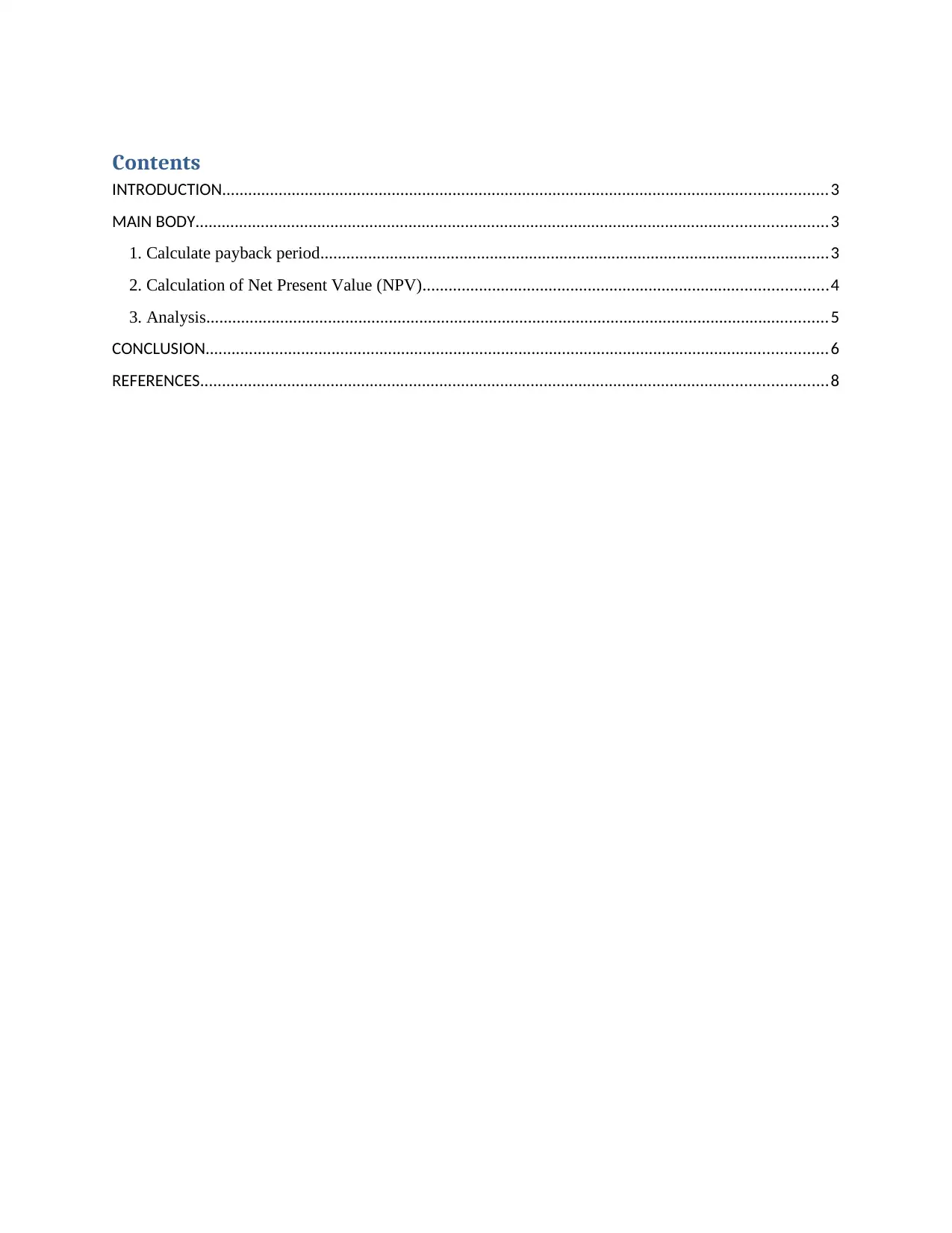
Contents
INTRODUCTION...........................................................................................................................................3
MAIN BODY.................................................................................................................................................3
1. Calculate payback period.....................................................................................................................3
2. Calculation of Net Present Value (NPV).............................................................................................4
3. Analysis...............................................................................................................................................5
CONCLUSION...............................................................................................................................................6
REFERENCES................................................................................................................................................8
INTRODUCTION...........................................................................................................................................3
MAIN BODY.................................................................................................................................................3
1. Calculate payback period.....................................................................................................................3
2. Calculation of Net Present Value (NPV).............................................................................................4
3. Analysis...............................................................................................................................................5
CONCLUSION...............................................................................................................................................6
REFERENCES................................................................................................................................................8
⊘ This is a preview!⊘
Do you want full access?
Subscribe today to unlock all pages.

Trusted by 1+ million students worldwide
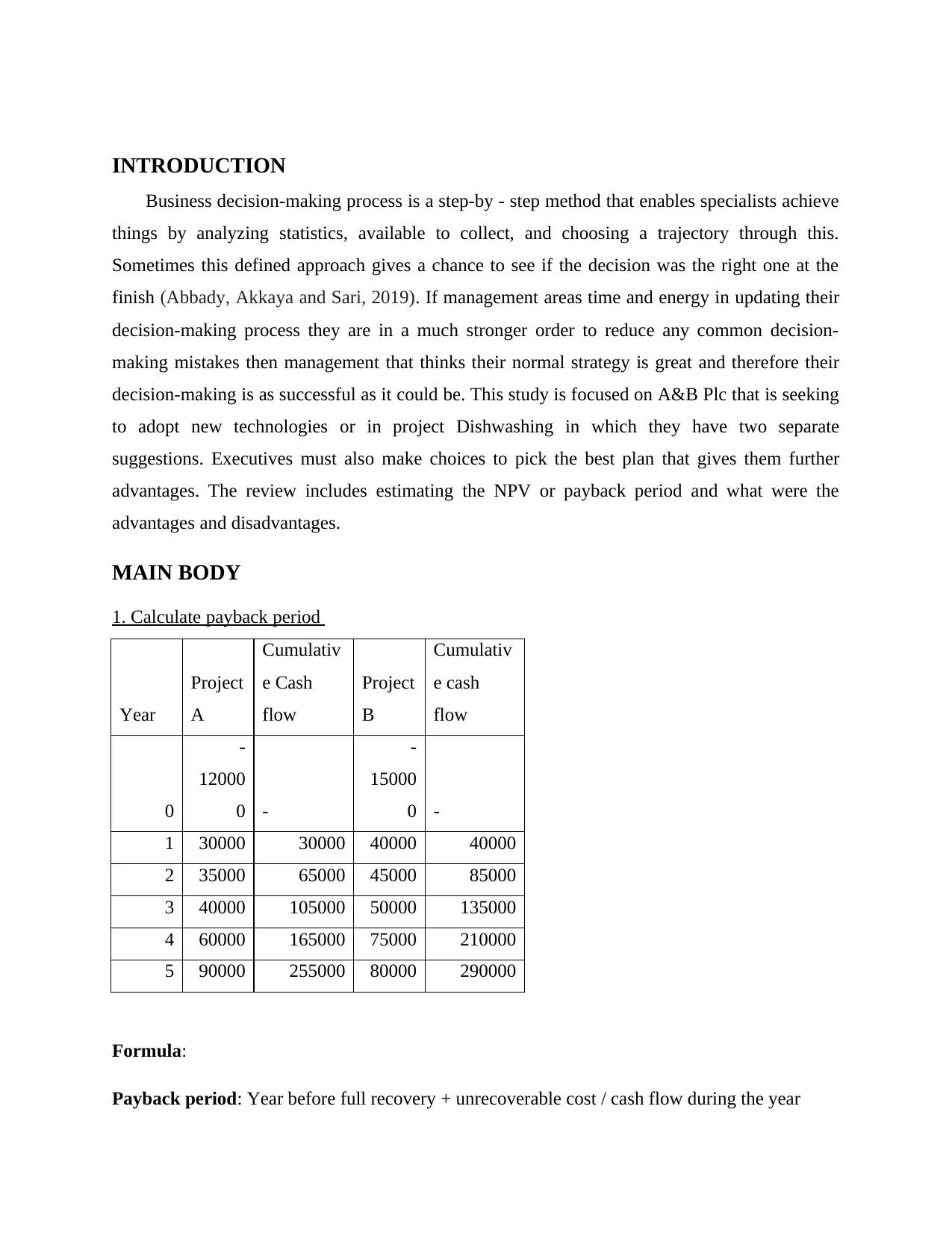
INTRODUCTION
Business decision-making process is a step-by - step method that enables specialists achieve
things by analyzing statistics, available to collect, and choosing a trajectory through this.
Sometimes this defined approach gives a chance to see if the decision was the right one at the
finish (Abbady, Akkaya and Sari, 2019). If management areas time and energy in updating their
decision-making process they are in a much stronger order to reduce any common decision-
making mistakes then management that thinks their normal strategy is great and therefore their
decision-making is as successful as it could be. This study is focused on A&B Plc that is seeking
to adopt new technologies or in project Dishwashing in which they have two separate
suggestions. Executives must also make choices to pick the best plan that gives them further
advantages. The review includes estimating the NPV or payback period and what were the
advantages and disadvantages.
MAIN BODY
1. Calculate payback period
Year
Project
A
Cumulativ
e Cash
flow
Project
B
Cumulativ
e cash
flow
0
-
12000
0 -
-
15000
0 -
1 30000 30000 40000 40000
2 35000 65000 45000 85000
3 40000 105000 50000 135000
4 60000 165000 75000 210000
5 90000 255000 80000 290000
Formula:
Payback period: Year before full recovery + unrecoverable cost / cash flow during the year
Business decision-making process is a step-by - step method that enables specialists achieve
things by analyzing statistics, available to collect, and choosing a trajectory through this.
Sometimes this defined approach gives a chance to see if the decision was the right one at the
finish (Abbady, Akkaya and Sari, 2019). If management areas time and energy in updating their
decision-making process they are in a much stronger order to reduce any common decision-
making mistakes then management that thinks their normal strategy is great and therefore their
decision-making is as successful as it could be. This study is focused on A&B Plc that is seeking
to adopt new technologies or in project Dishwashing in which they have two separate
suggestions. Executives must also make choices to pick the best plan that gives them further
advantages. The review includes estimating the NPV or payback period and what were the
advantages and disadvantages.
MAIN BODY
1. Calculate payback period
Year
Project
A
Cumulativ
e Cash
flow
Project
B
Cumulativ
e cash
flow
0
-
12000
0 -
-
15000
0 -
1 30000 30000 40000 40000
2 35000 65000 45000 85000
3 40000 105000 50000 135000
4 60000 165000 75000 210000
5 90000 255000 80000 290000
Formula:
Payback period: Year before full recovery + unrecoverable cost / cash flow during the year
Paraphrase This Document
Need a fresh take? Get an instant paraphrase of this document with our AI Paraphraser
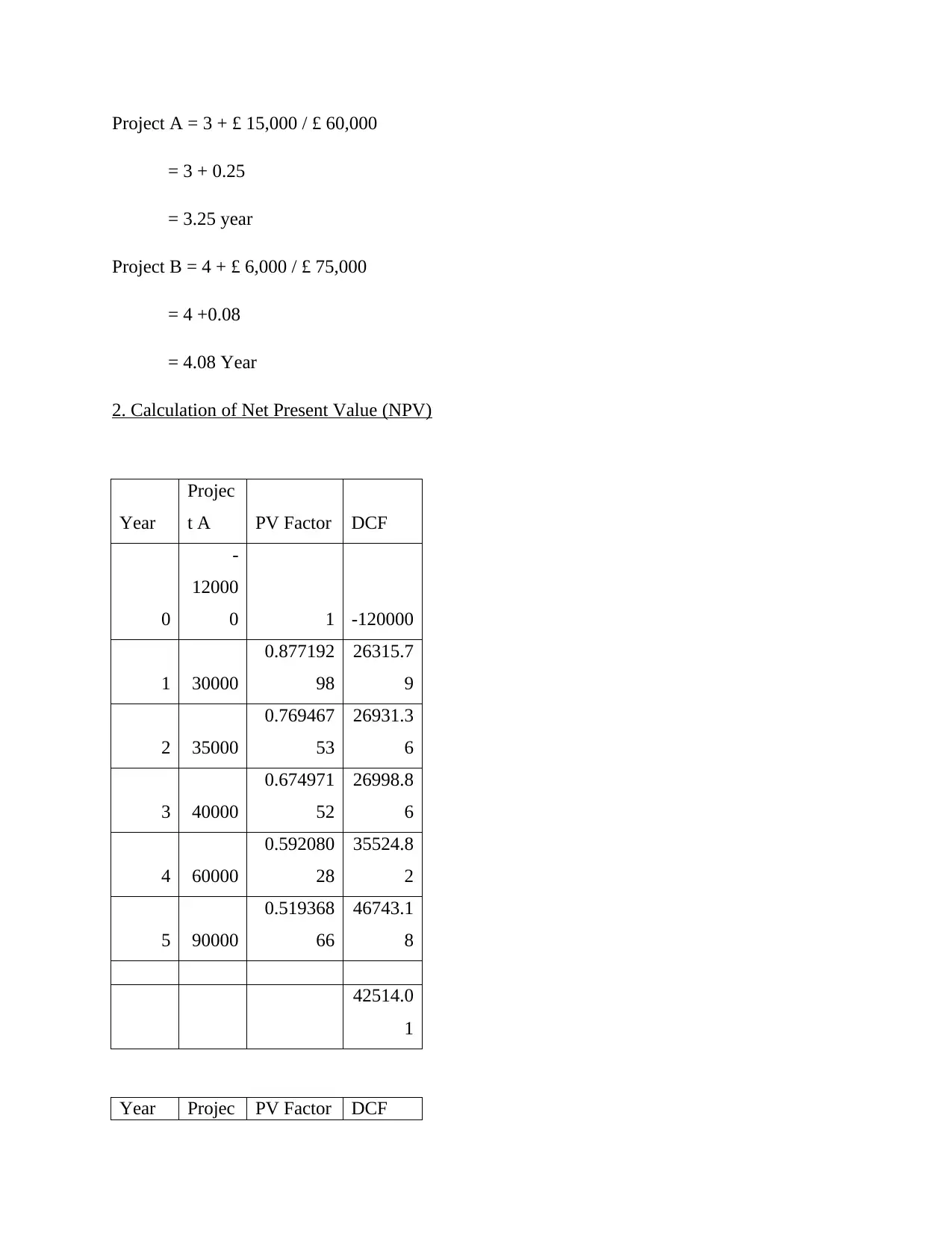
Project A = 3 + £ 15,000 / £ 60,000
= 3 + 0.25
= 3.25 year
Project B = 4 + £ 6,000 / £ 75,000
= 4 +0.08
= 4.08 Year
2. Calculation of Net Present Value (NPV)
Year
Projec
t A PV Factor DCF
0
-
12000
0 1 -120000
1 30000
0.877192
98
26315.7
9
2 35000
0.769467
53
26931.3
6
3 40000
0.674971
52
26998.8
6
4 60000
0.592080
28
35524.8
2
5 90000
0.519368
66
46743.1
8
42514.0
1
Year Projec PV Factor DCF
= 3 + 0.25
= 3.25 year
Project B = 4 + £ 6,000 / £ 75,000
= 4 +0.08
= 4.08 Year
2. Calculation of Net Present Value (NPV)
Year
Projec
t A PV Factor DCF
0
-
12000
0 1 -120000
1 30000
0.877192
98
26315.7
9
2 35000
0.769467
53
26931.3
6
3 40000
0.674971
52
26998.8
6
4 60000
0.592080
28
35524.8
2
5 90000
0.519368
66
46743.1
8
42514.0
1
Year Projec PV Factor DCF
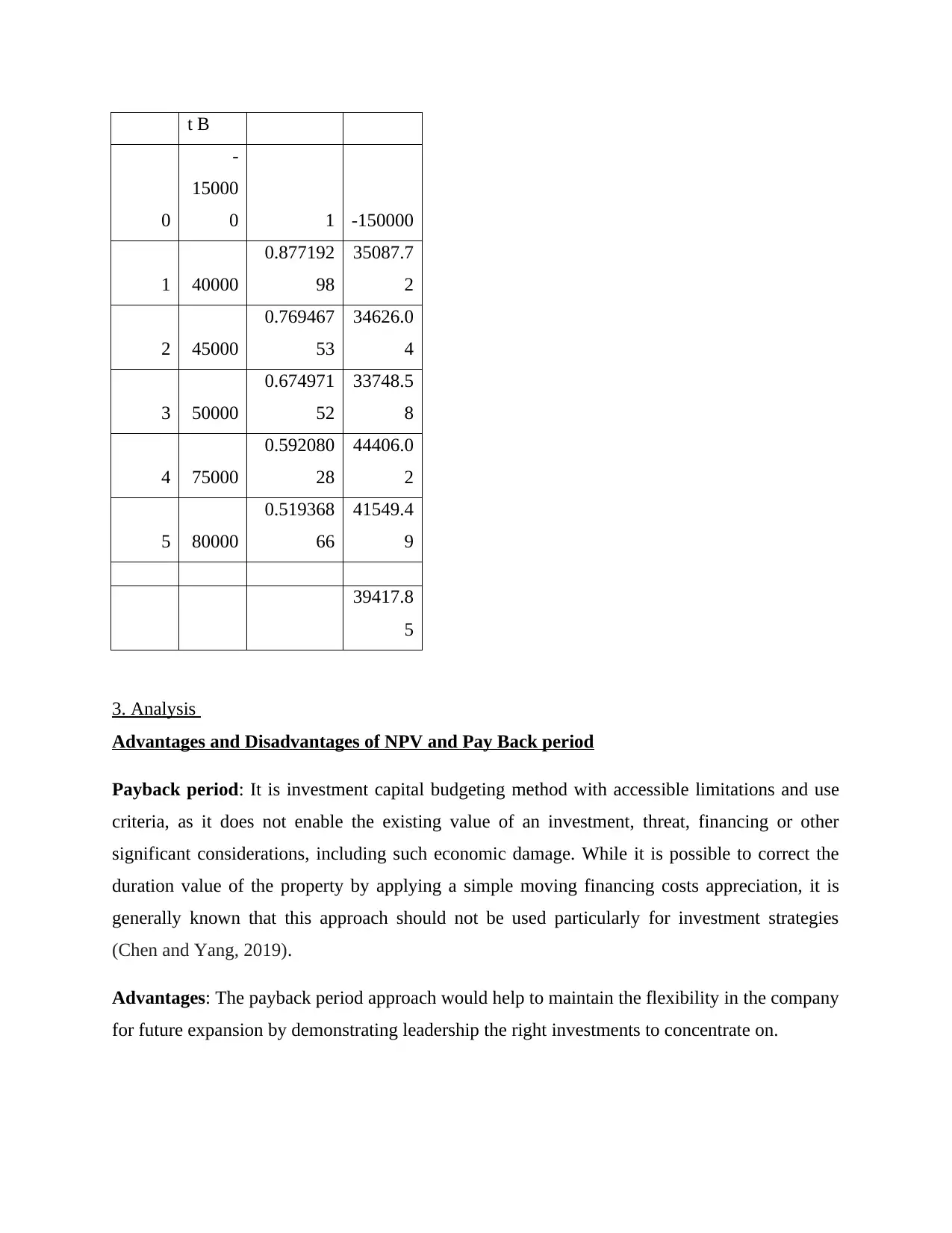
t B
0
-
15000
0 1 -150000
1 40000
0.877192
98
35087.7
2
2 45000
0.769467
53
34626.0
4
3 50000
0.674971
52
33748.5
8
4 75000
0.592080
28
44406.0
2
5 80000
0.519368
66
41549.4
9
39417.8
5
3. Analysis
Advantages and Disadvantages of NPV and Pay Back period
Payback period: It is investment capital budgeting method with accessible limitations and use
criteria, as it does not enable the existing value of an investment, threat, financing or other
significant considerations, including such economic damage. While it is possible to correct the
duration value of the property by applying a simple moving financing costs appreciation, it is
generally known that this approach should not be used particularly for investment strategies
(Chen and Yang, 2019).
Advantages: The payback period approach would help to maintain the flexibility in the company
for future expansion by demonstrating leadership the right investments to concentrate on.
0
-
15000
0 1 -150000
1 40000
0.877192
98
35087.7
2
2 45000
0.769467
53
34626.0
4
3 50000
0.674971
52
33748.5
8
4 75000
0.592080
28
44406.0
2
5 80000
0.519368
66
41549.4
9
39417.8
5
3. Analysis
Advantages and Disadvantages of NPV and Pay Back period
Payback period: It is investment capital budgeting method with accessible limitations and use
criteria, as it does not enable the existing value of an investment, threat, financing or other
significant considerations, including such economic damage. While it is possible to correct the
duration value of the property by applying a simple moving financing costs appreciation, it is
generally known that this approach should not be used particularly for investment strategies
(Chen and Yang, 2019).
Advantages: The payback period approach would help to maintain the flexibility in the company
for future expansion by demonstrating leadership the right investments to concentrate on.
⊘ This is a preview!⊘
Do you want full access?
Subscribe today to unlock all pages.

Trusted by 1+ million students worldwide
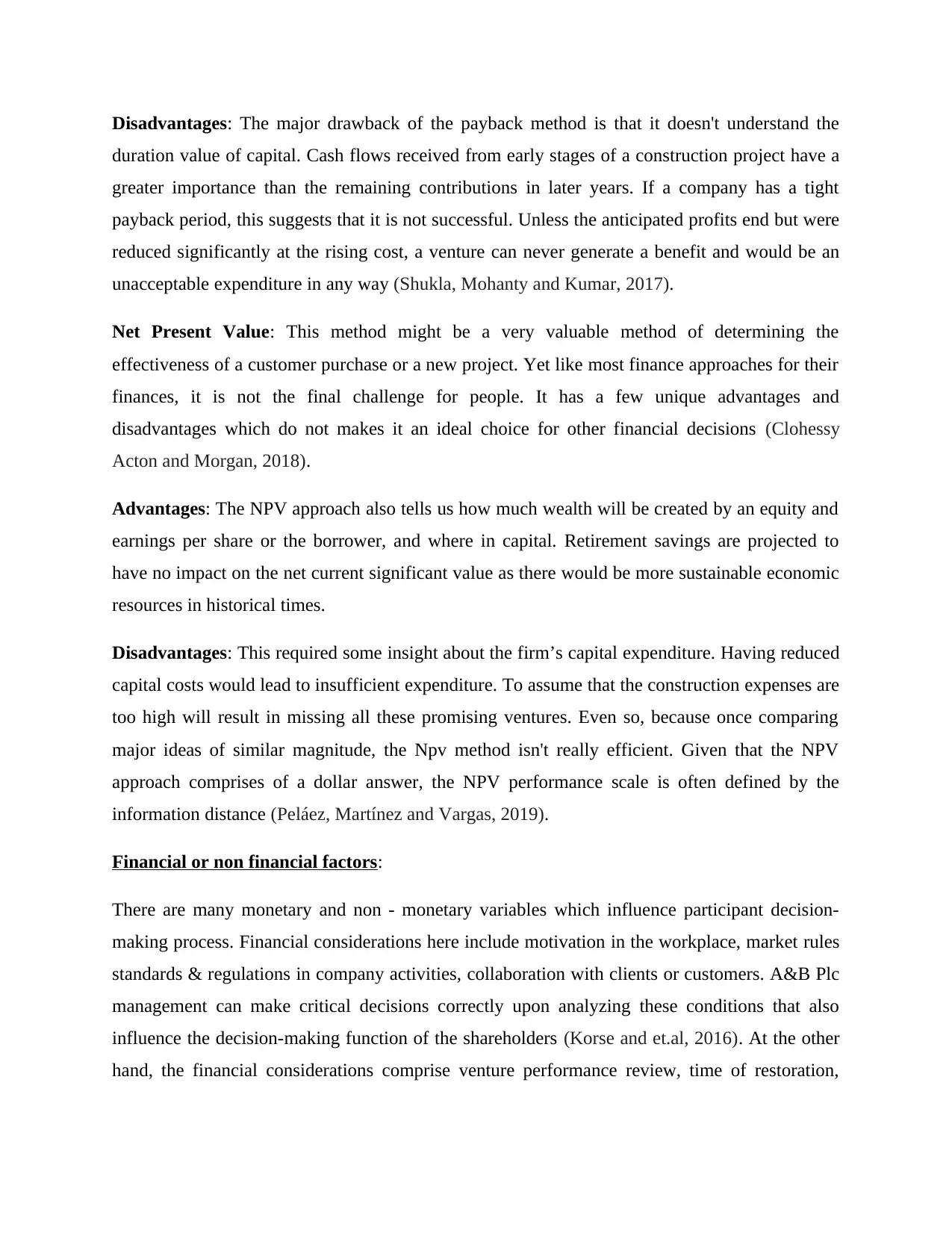
Disadvantages: The major drawback of the payback method is that it doesn't understand the
duration value of capital. Cash flows received from early stages of a construction project have a
greater importance than the remaining contributions in later years. If a company has a tight
payback period, this suggests that it is not successful. Unless the anticipated profits end but were
reduced significantly at the rising cost, a venture can never generate a benefit and would be an
unacceptable expenditure in any way (Shukla, Mohanty and Kumar, 2017).
Net Present Value: This method might be a very valuable method of determining the
effectiveness of a customer purchase or a new project. Yet like most finance approaches for their
finances, it is not the final challenge for people. It has a few unique advantages and
disadvantages which do not makes it an ideal choice for other financial decisions (Clohessy
Acton and Morgan, 2018).
Advantages: The NPV approach also tells us how much wealth will be created by an equity and
earnings per share or the borrower, and where in capital. Retirement savings are projected to
have no impact on the net current significant value as there would be more sustainable economic
resources in historical times.
Disadvantages: This required some insight about the firm’s capital expenditure. Having reduced
capital costs would lead to insufficient expenditure. To assume that the construction expenses are
too high will result in missing all these promising ventures. Even so, because once comparing
major ideas of similar magnitude, the Npv method isn't really efficient. Given that the NPV
approach comprises of a dollar answer, the NPV performance scale is often defined by the
information distance (Peláez, Martínez and Vargas, 2019).
Financial or non financial factors:
There are many monetary and non - monetary variables which influence participant decision-
making process. Financial considerations here include motivation in the workplace, market rules
standards & regulations in company activities, collaboration with clients or customers. A&B Plc
management can make critical decisions correctly upon analyzing these conditions that also
influence the decision-making function of the shareholders (Korse and et.al, 2016). At the other
hand, the financial considerations comprise venture performance review, time of restoration,
duration value of capital. Cash flows received from early stages of a construction project have a
greater importance than the remaining contributions in later years. If a company has a tight
payback period, this suggests that it is not successful. Unless the anticipated profits end but were
reduced significantly at the rising cost, a venture can never generate a benefit and would be an
unacceptable expenditure in any way (Shukla, Mohanty and Kumar, 2017).
Net Present Value: This method might be a very valuable method of determining the
effectiveness of a customer purchase or a new project. Yet like most finance approaches for their
finances, it is not the final challenge for people. It has a few unique advantages and
disadvantages which do not makes it an ideal choice for other financial decisions (Clohessy
Acton and Morgan, 2018).
Advantages: The NPV approach also tells us how much wealth will be created by an equity and
earnings per share or the borrower, and where in capital. Retirement savings are projected to
have no impact on the net current significant value as there would be more sustainable economic
resources in historical times.
Disadvantages: This required some insight about the firm’s capital expenditure. Having reduced
capital costs would lead to insufficient expenditure. To assume that the construction expenses are
too high will result in missing all these promising ventures. Even so, because once comparing
major ideas of similar magnitude, the Npv method isn't really efficient. Given that the NPV
approach comprises of a dollar answer, the NPV performance scale is often defined by the
information distance (Peláez, Martínez and Vargas, 2019).
Financial or non financial factors:
There are many monetary and non - monetary variables which influence participant decision-
making process. Financial considerations here include motivation in the workplace, market rules
standards & regulations in company activities, collaboration with clients or customers. A&B Plc
management can make critical decisions correctly upon analyzing these conditions that also
influence the decision-making function of the shareholders (Korse and et.al, 2016). At the other
hand, the financial considerations comprise venture performance review, time of restoration,
Paraphrase This Document
Need a fresh take? Get an instant paraphrase of this document with our AI Paraphraser
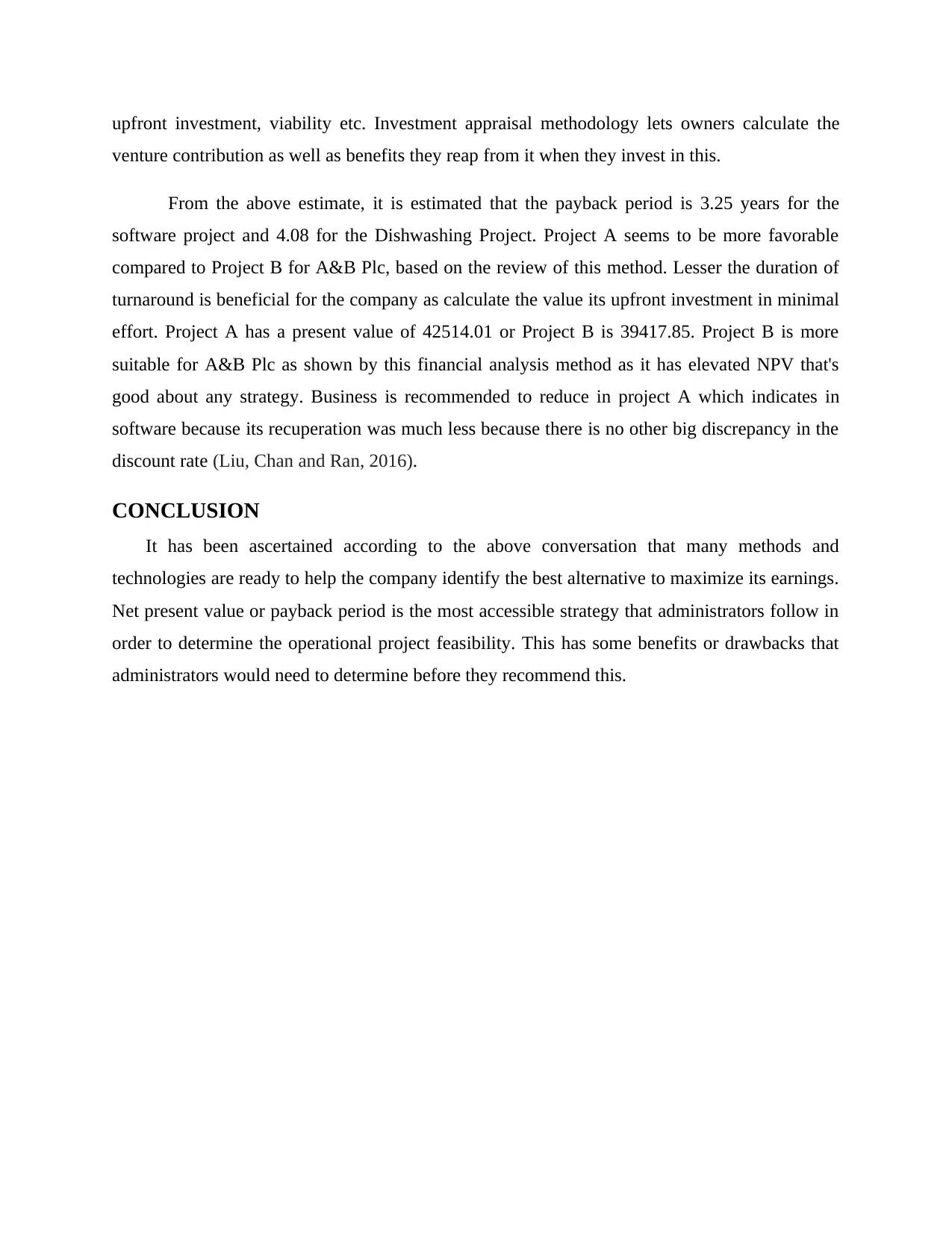
upfront investment, viability etc. Investment appraisal methodology lets owners calculate the
venture contribution as well as benefits they reap from it when they invest in this.
From the above estimate, it is estimated that the payback period is 3.25 years for the
software project and 4.08 for the Dishwashing Project. Project A seems to be more favorable
compared to Project B for A&B Plc, based on the review of this method. Lesser the duration of
turnaround is beneficial for the company as calculate the value its upfront investment in minimal
effort. Project A has a present value of 42514.01 or Project B is 39417.85. Project B is more
suitable for A&B Plc as shown by this financial analysis method as it has elevated NPV that's
good about any strategy. Business is recommended to reduce in project A which indicates in
software because its recuperation was much less because there is no other big discrepancy in the
discount rate (Liu, Chan and Ran, 2016).
CONCLUSION
It has been ascertained according to the above conversation that many methods and
technologies are ready to help the company identify the best alternative to maximize its earnings.
Net present value or payback period is the most accessible strategy that administrators follow in
order to determine the operational project feasibility. This has some benefits or drawbacks that
administrators would need to determine before they recommend this.
venture contribution as well as benefits they reap from it when they invest in this.
From the above estimate, it is estimated that the payback period is 3.25 years for the
software project and 4.08 for the Dishwashing Project. Project A seems to be more favorable
compared to Project B for A&B Plc, based on the review of this method. Lesser the duration of
turnaround is beneficial for the company as calculate the value its upfront investment in minimal
effort. Project A has a present value of 42514.01 or Project B is 39417.85. Project B is more
suitable for A&B Plc as shown by this financial analysis method as it has elevated NPV that's
good about any strategy. Business is recommended to reduce in project A which indicates in
software because its recuperation was much less because there is no other big discrepancy in the
discount rate (Liu, Chan and Ran, 2016).
CONCLUSION
It has been ascertained according to the above conversation that many methods and
technologies are ready to help the company identify the best alternative to maximize its earnings.
Net present value or payback period is the most accessible strategy that administrators follow in
order to determine the operational project feasibility. This has some benefits or drawbacks that
administrators would need to determine before they recommend this.
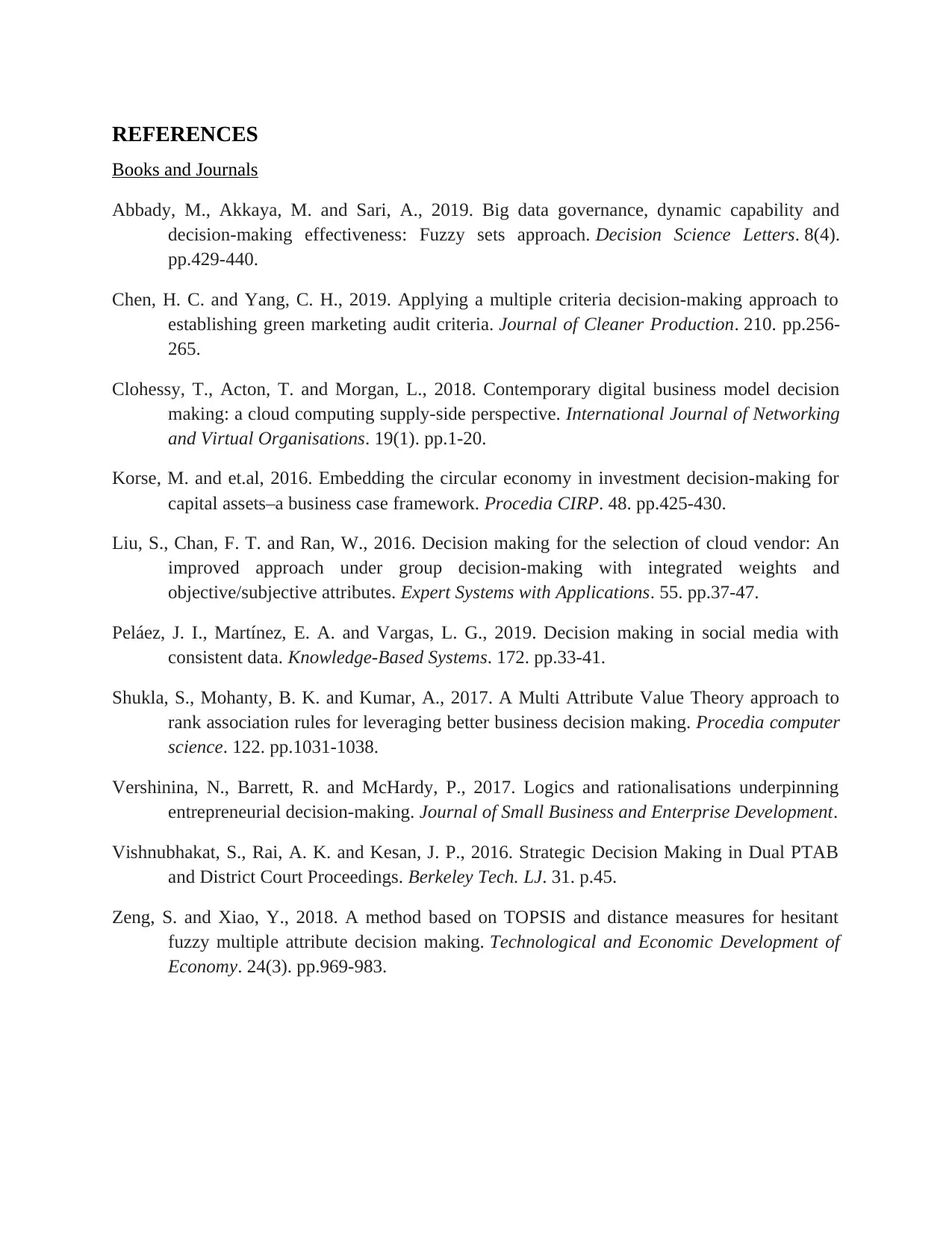
REFERENCES
Books and Journals
Abbady, M., Akkaya, M. and Sari, A., 2019. Big data governance, dynamic capability and
decision-making effectiveness: Fuzzy sets approach. Decision Science Letters. 8(4).
pp.429-440.
Chen, H. C. and Yang, C. H., 2019. Applying a multiple criteria decision-making approach to
establishing green marketing audit criteria. Journal of Cleaner Production. 210. pp.256-
265.
Clohessy, T., Acton, T. and Morgan, L., 2018. Contemporary digital business model decision
making: a cloud computing supply-side perspective. International Journal of Networking
and Virtual Organisations. 19(1). pp.1-20.
Korse, M. and et.al, 2016. Embedding the circular economy in investment decision-making for
capital assets–a business case framework. Procedia CIRP. 48. pp.425-430.
Liu, S., Chan, F. T. and Ran, W., 2016. Decision making for the selection of cloud vendor: An
improved approach under group decision-making with integrated weights and
objective/subjective attributes. Expert Systems with Applications. 55. pp.37-47.
Peláez, J. I., Martínez, E. A. and Vargas, L. G., 2019. Decision making in social media with
consistent data. Knowledge-Based Systems. 172. pp.33-41.
Shukla, S., Mohanty, B. K. and Kumar, A., 2017. A Multi Attribute Value Theory approach to
rank association rules for leveraging better business decision making. Procedia computer
science. 122. pp.1031-1038.
Vershinina, N., Barrett, R. and McHardy, P., 2017. Logics and rationalisations underpinning
entrepreneurial decision-making. Journal of Small Business and Enterprise Development.
Vishnubhakat, S., Rai, A. K. and Kesan, J. P., 2016. Strategic Decision Making in Dual PTAB
and District Court Proceedings. Berkeley Tech. LJ. 31. p.45.
Zeng, S. and Xiao, Y., 2018. A method based on TOPSIS and distance measures for hesitant
fuzzy multiple attribute decision making. Technological and Economic Development of
Economy. 24(3). pp.969-983.
Books and Journals
Abbady, M., Akkaya, M. and Sari, A., 2019. Big data governance, dynamic capability and
decision-making effectiveness: Fuzzy sets approach. Decision Science Letters. 8(4).
pp.429-440.
Chen, H. C. and Yang, C. H., 2019. Applying a multiple criteria decision-making approach to
establishing green marketing audit criteria. Journal of Cleaner Production. 210. pp.256-
265.
Clohessy, T., Acton, T. and Morgan, L., 2018. Contemporary digital business model decision
making: a cloud computing supply-side perspective. International Journal of Networking
and Virtual Organisations. 19(1). pp.1-20.
Korse, M. and et.al, 2016. Embedding the circular economy in investment decision-making for
capital assets–a business case framework. Procedia CIRP. 48. pp.425-430.
Liu, S., Chan, F. T. and Ran, W., 2016. Decision making for the selection of cloud vendor: An
improved approach under group decision-making with integrated weights and
objective/subjective attributes. Expert Systems with Applications. 55. pp.37-47.
Peláez, J. I., Martínez, E. A. and Vargas, L. G., 2019. Decision making in social media with
consistent data. Knowledge-Based Systems. 172. pp.33-41.
Shukla, S., Mohanty, B. K. and Kumar, A., 2017. A Multi Attribute Value Theory approach to
rank association rules for leveraging better business decision making. Procedia computer
science. 122. pp.1031-1038.
Vershinina, N., Barrett, R. and McHardy, P., 2017. Logics and rationalisations underpinning
entrepreneurial decision-making. Journal of Small Business and Enterprise Development.
Vishnubhakat, S., Rai, A. K. and Kesan, J. P., 2016. Strategic Decision Making in Dual PTAB
and District Court Proceedings. Berkeley Tech. LJ. 31. p.45.
Zeng, S. and Xiao, Y., 2018. A method based on TOPSIS and distance measures for hesitant
fuzzy multiple attribute decision making. Technological and Economic Development of
Economy. 24(3). pp.969-983.
⊘ This is a preview!⊘
Do you want full access?
Subscribe today to unlock all pages.

Trusted by 1+ million students worldwide
1 out of 9
Related Documents
Your All-in-One AI-Powered Toolkit for Academic Success.
+13062052269
info@desklib.com
Available 24*7 on WhatsApp / Email
![[object Object]](/_next/static/media/star-bottom.7253800d.svg)
Unlock your academic potential
Copyright © 2020–2025 A2Z Services. All Rights Reserved. Developed and managed by ZUCOL.





